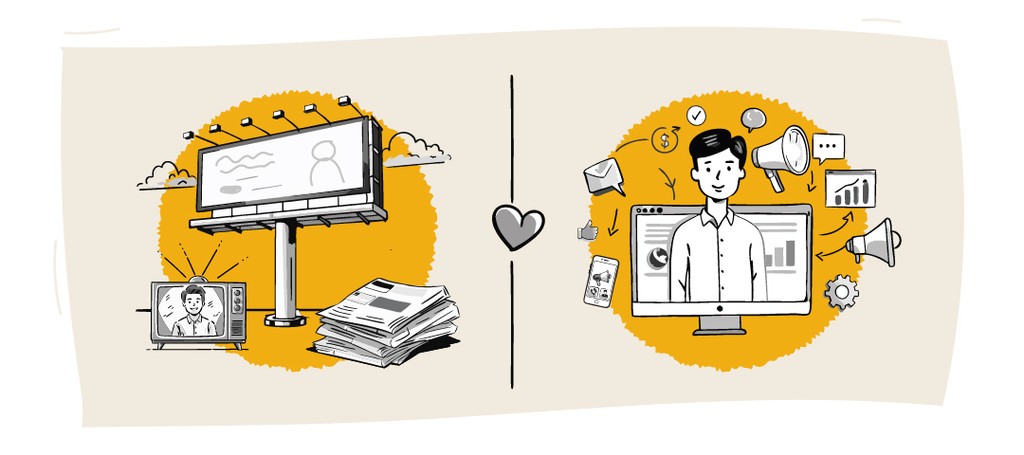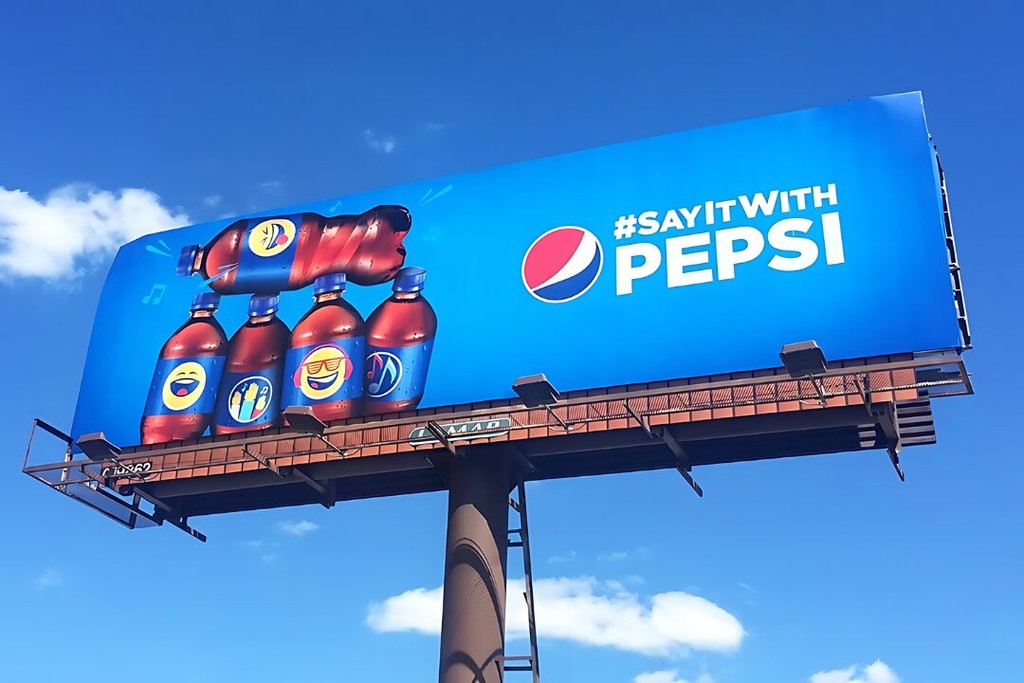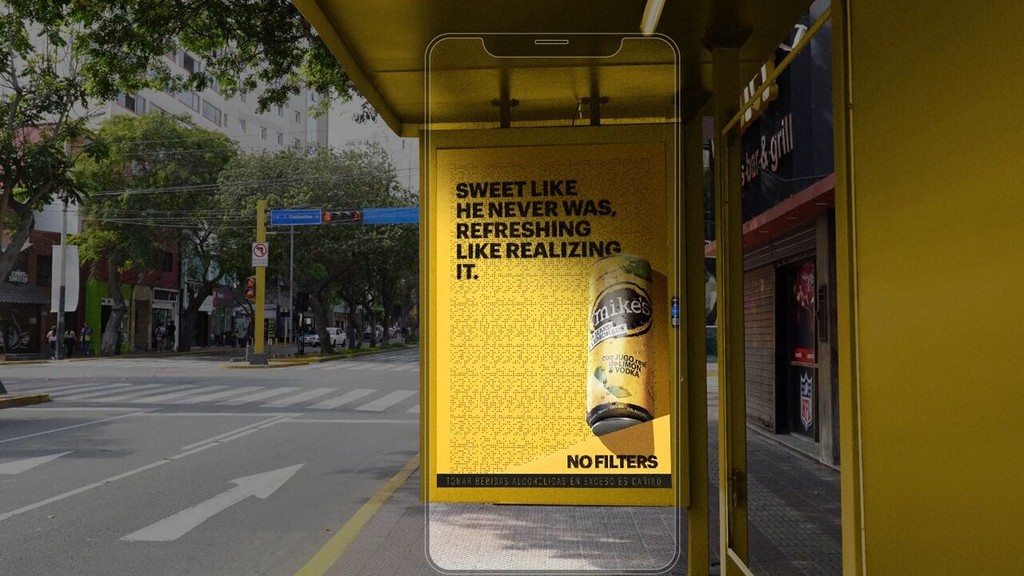Digital Marketing vs Traditional Marketing in 2025
Table of contents
- What is Traditional Marketing?
- Pros and Cons of Traditional Marketing
- What is Digital Marketing?
- Pros and Cons of Digital Marketing
- Digital Marketing vs Traditional Marketing
- Market Shift Towards Digital Marketing
- How Brands are Leveraging Digital Marketing?
- Frequently Asked Questions
Hey there, fellow Digital Natives and Marketing Enthusiast! In a world where scrolling is the new window shopping and hashtags hold more influence than billboards, the digital marketing vs traditional marketing battle has reached a titanic height. Have you ever been caught between the compelling appeal of digital methods and the nostalgic charm of traditional marketing?
Well, You’re not alone! Come along with me as we explore the wild area of marketing and sort through an age-old debate to see which strategy really appeals to our Gen Z audience’s emotions (and money). Get ready to dive deep into it! and possibly even a few unexpected narrative twists awaits you!
In this blog we will cover:
- What is Traditional Marketing?
- Pros and Cons of Traditional Marketing
- What is Digital Marketing?
- Pros and Cons of Digital Marketing
- Digital Marketing vs Traditional Marketing
- Market Shift Towards Digital Marketing
- How Brands are Leveraging Digital Marketing?
What is Traditional Marketing?
Traditional marketing refers to any type of marketing that isn’t online. These are the methods that have been around for decades and are typically used less often now. However, they’re not without their strengths.
Common traditional market methods include:
- Directly mailed postcards, coupons, and informational packets
- Television or radio commercials
- Newspaper or magazine ads
- Billboards and flyers
- Telephone calls and text notifications
- Events and Networking
Traditional marketing is not only one of the oldest forms of marketing, but also one of the most researched. Everyone encounters some sort of traditional marketing in their everyday lives, whether it’s getting the mail or your daily newspaper. We see and hear many of these ads every day just by listening to the radio on the way to work or even looking out the window at the billboards as we go by. They’ve become a part of daily life.
Pros and Cons of Traditional Marketing
Pros of Traditional Marketing
- Local Targeting – It is easier to reach out to a local audience with traditional marketing. For example, through radio broadcasts and billboards you can target the people of a particular town or city with ease. It can also help target rural areas where newspaper, radio, and television marketing work better. Ads can be kept for a long period of time, if they’re physical.
- Easily processed – Information in hard copies is easier to mentally process, remember and recall in the future.
- Highly Effective – Traditional marketing has a good success rate as it is an age-old method of marketing and Marketers lean towards this method because it’s tried and true.
Cons of Traditional Marketing
- Costly – It is more expensive compared to digital marketing. There are printing costs involved for newspapers, magazines, pamphlets, fliers, etc. Running advertisements on the radio and television is costly as well and billboards need to be rented. In digital marketing, there are fewer costs involved.
- Difficult to Track – The downside to traditional marketing is that there are ways of tracking the results of the campaign but there is no in-depth analysis. Hence, there is no one way of knowing what could have been done better or differently or what went right or wrong in the previous campaigns.
- Decrease in Popularity – Many brands prefer going online to sticking to traditional marketing methods such as newspapers and magazines. The internet has a higher reach and is easily accessible to most people. To dig deeper, some digital marketing vs traditional marketing statistics state that around 60% of businesses have already shifted their marketing efforts to digital marketing.
- Harder to target specific people and groups – Digital marketing allows you to target more specific areas of your target audience, whereas traditional marketing methods can’t offer the same level of segmentation.
What is Digital Marketing?
Digital marketing is … well … digital. Digital marketing is any marketing a company conducts online. Digital marketing has become wildly popular due to the cultural, technological, and societal shifts around us. Gen Z’s era! right!!
Digital Marketing Strategies evolve quickly because of trends and new technology. These strategies include those that require the use of the internet or smartphones. They haven’t been around as long as traditional methods, but they certainly pack a punch.
Common digital marketing methods include:
- Website
- Email campaigns
- SEO
- Blog
- PPC or clickable ads
- Social media posts
- Videos on website
- YouTube videos
- Affiliate marketing
- Online contests
These strategies are very popular today because of consumers’ frequent usage of the internet and mobile devices. According to the Data Reportal, there are 5.44 billion active internet users in the world and 5.07 billion active Social Media users. With numbers that high, marketing online and through social media makes a lot of sense.
Digital marketing is essential for businesses today. It’s become routine for consumers to conduct research and make purchases online. Just this week, I’ve looked up lunch spots, priced couches, and picked an eye doctor — all using the internet. With all this information, which route should your company go with?
If you want to start a career in digital marketing, you may like this digital marketing course.
Pros and Cons of Digital Marketing
Pros of Digital Marketing
- Cost-efficient – If you’re on a low budget, digital marketing is perfect for you. The best part is that you can do a lot with a limited budget and get exactly what you want. It is much more cost-efficient than traditional marketing and it is much easier to control and track the budgets as well.
- Reach – The reach is global when it comes to digital marketing and the investment involved can be minimal.
- Measurable results – The marketing results are real-time and trackable. You can track how a user navigates your website, leads, conversions and so much more. With many metrics to choose from, you can get an in-depth analysis of your marketing efforts.
- Targeting – With digital marketing, it is much easier to know that your communication is targeting the right audience. With filters, you can set specific attributes for your target audience narrowing down relevant users.
- Interactive – Digital marketing is highly interactive as it makes use of a two-way approach to communication. You can easily strategize your communication to be conversational to increase engagement on your page.
- Immediate Conversions – In the case of websites, social media posts, etc. conversions are on-the-spot unlike traditional marketing wherein a user is directed to a phone number or a physical store.
Cons of Digital Marketing
- High Competition – With digital marketing, there is global reach which means there is also a global competition to tackle. It is difficult to stand out from the crowd – your product/service and communication need to be very unique.
- Skills and Training – Creating digital marketing campaigns and training marketing executives is very time-consuming.
- Fast-changing – Marketing tools and trends are fast-changing and hence, it is important to keep up to date with them.
- Tedious CRM – Carrying out CRM (customer relationship management) can be very challenging. Negative feedback would be displayed on your website for all your users to view and can affect your brand reputation. Managing it is also a task.
Digital Marketing vs Traditional Marketing
If we talk about digital marketing vs traditional marketing, traditional marketing offers tangible things but little in the way of targeting and interactivity. It uses traditional media like TV, radio, print, and billboards to reach a large audience. Even if it can be expensive and difficult to calculate ROI precisely, it nevertheless has a large audience and some consumers still find it reliable. Conversely, digital marketing makes use of internet tools and platforms to target particular demographics with customized messaging, encouraging interaction and providing real-time information for improved optimization. Although internet marketing is more affordable and has more accurate targeting options than traditional approaches, it doesn’t have the same physical presence. In today’s changing environment, the most successful marketing strategies generally combine traditional and digital tactics in a smart way to enhance reach, engagement, and return on investment.
Here is a detailed comparison of Traditional vs Digital Marketing which can help for better understanding:
| Features | Traditional Marketing | Digital Marketing |
| Cost | Typically Higher | Lower and Affordable |
| Reach | Localized | Global |
| Engagement | Low | High |
| Targeting | Wide Targeting | Highly Specific |
| Communication | One-Way | Interactive |
| Brand Presence | Local | Local and Global |
| Relevancy | Ideal for Longer Brands | Ideal for All Brands |
| Conversion | Slow | Fast |
| Tracking | Not Possible | Possible |
| Strategy Change | Not Possible | Possible |
| Adaptability | Less Flexible | Highly Adaptable |
| ROI Measurement | Difficult to Measure | Easy and Detailed |
| Content Lifespan | Longer in Most Forms | Varies (often Shorter) |
| Real Time Analytics | Hard to Analyze | Immediate Insights Possibles |
Market Shift Towards Digital Marketing
Let’s go back to a period when traditional marketing ruled the day. Imagine a busy city street dotted with tall billboards that are all competing for people’s attention amid the traffic. When we fast-forward to the present, the scene appears somewhat different. The digital arena, where marketers fight for clicks and likes in the immensity of cyberspace, has displaced those billboards.
Consider Coca-Cola as an example. The beverage giant, formerly recognized for its memorable print advertisements and catchy jingles, is now aggressively investing in digital campaigns that precisely target particular demographics. Coca-Cola has embraced the digital era head-on, winning over a new generation of consumers with targeted social media marketing and immersive augmented reality experiences.
In this constantly changing environment, flexibility is essential. Companies that previously only used traditional marketing methods are now embracing the digital revolution as they see the value of real-time engagement and data-driven insights. These days, building lasting relationships is more important than merely making sales in a world where consumers have short attention spans and intense competition. So keep this in mind the next time you grab your phone or browse through social media: you’re seeing more than simply a change in advertising tactics. You’re seeing the birth of an industry where creativity and invention have no boundaries. Welcome to the future of marketing.
How Brands are Leveraging Digital Marketing?
Here are two great examples of Indian brands that have leveraged digital marketing to increase their reach and followers:
Zomato’s Social Media Savvy
Zomato, India’s leading food delivery and restaurant discovery platform, has become synonymous with digital marketing innovation. Through its witty and relatable social media presence on platforms like Twitter and Instagram, Zomato has built a loyal following of food enthusiasts and tech-savvy consumers. By engaging with its audience through interactive polls, mouth-watering food photos, and clever memes, Zomato keeps its followers entertained while subtly promoting its services. Additionally, Zomato’s user-generated content initiatives, such as its popular #ZomatoStories campaign encourages customers to share their dining experiences, further extending the brand’s reach and influence. With its strategic use of digital marketing, Zomato has successfully expanded its user base and solidified its position as a market leader in the food delivery industry.
Nykaa’s Beauty Community Building
Nykaa, India’s premier online beauty retailer, has capitalized on the power of digital marketing to foster a vibrant community of beauty enthusiasts. Through its engaging content strategy on platforms like Instagram, YouTube, and its own blog, Nykaa offers beauty tips, tutorials, product reviews, and trend forecasts, catering to the diverse needs and preferences of its audience. Nykaa’s collaborations with beauty influencers and celebrities, along with its user-generated content campaigns like #NykaaBeauty, have further amplified its reach and strengthened its brand presence. By providing valuable content and cultivating a sense of belonging among its followers, Nykaa has garnered a massive following of loyal customers who turn to the brand for their beauty needs. With successful digital marketing efforts, Nykaa continues to thrive in India’s competitive beauty industry landscape.
Finally, there are countless options for brands to broaden their reach, interact with consumers, and grow in the dynamic field of digital marketing. Digital marketing provides marketers with an abundance of tools to utilize, ranging from cutting-edge trends like social media influencers to data-driven methods like targeted advertising. But as we’ve seen, traditional marketing continues to be effective because of its widespread appeal and physical presence.
The question still stands, though: is it possible for these two worlds to coexist peacefully and produce a marketing plan that is more effective as a whole? Let’s think about this: in a world where traditional charm and digital innovation coexist, perhaps the secret to success lies in a perfect balance between old-school wisdom and cutting-edge technology.
Wait ! Here’s a great example of perfect balance:
Imagine walking down the street and spotting a billboard with a QR code placed next to a product. Curiosity piqued, you whip out your phone, scan the code, and find yourself directed to a landing page offering exclusive deals and behind-the-scenes content related to the advertised product. In this scenario, the traditional billboard serves as a gateway to the digital world, seamlessly integrating offline and online experiences to engage consumers in a dynamic marketing journey.
The question shouldn’t be “Digital Marketing vs Traditional Marketing”. Instead, try “How do we use both tactics to market effectively?” Of course, some businesses may benefit from going one way or the other, but on the whole, it is possible for both methods to thrive harmoniously.
Frequently Asked Questions
What are a few types of modern marketing techniques?
Modern marketing techniques include digital marketing, social media marketing, content marketing, influencer marketing, email marketing, and search engine optimization (SEO).
How effective is traditional marketing?
Traditional marketing, such as TV, radio, print, and direct mail, remains effective for reaching local audiences and older demographics, building brand awareness, and fostering trust through established media channels.
Which type of marketing is more cost-effective?
Digital marketing is generally more cost-effective due to its targeted approach, measurable results, and lower costs for reach and engagement compared to traditional marketing.


















